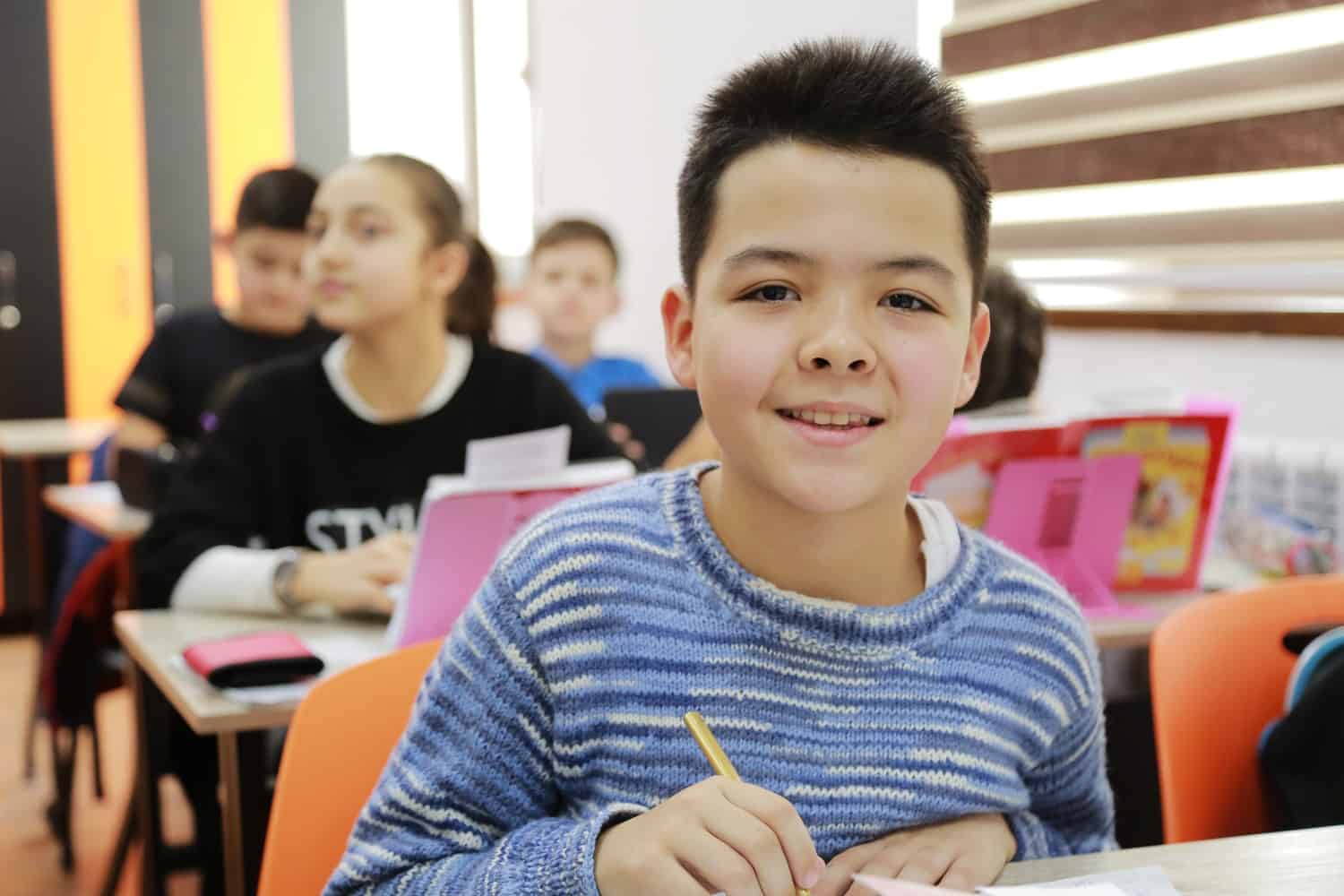Here’s a fast fact: over 60% of all misunderstandings come from poor listening and only 1% from poor reading.[11] If you don’t currently teach your students specifically how to listen, it may be time to add activities to your curriculum that strengthen this skill. The benefits of strong listening skills may begin in class, but they extend through all aspects of your student’s academic and personal lives.
In this guide, we’ll teach you why and how to teach your students how to listen—as well as all about active listening, a strategy you can use to help students focus on and understand your lessons more effectively.
What’s the Difference Between Active and Passive Listening?
 Before diving into why it’s important to teach effective listening skills, let’s go over what exactly that looks like. One great way to think of positive versus negative listening skills is through the example of active and passive listening.
Before diving into why it’s important to teach effective listening skills, let’s go over what exactly that looks like. One great way to think of positive versus negative listening skills is through the example of active and passive listening.
Active listening, loosely defined, is paying attention to a speaker and listening to understand, not to respond.[8] It also includes complete focus on the speaker with minimal distractions out of respect and an intent to learn. In school, one example of active listening would be a student waiting their turn and considering what their peers have to say before stating their opinion in a classroom discussion.
Passive listening, however, is like listening while multitasking.[9] A passive listener might pay attention to a speaker with the sole intent to respond or place some of their attention in another task. A classroom example of passive listening? Students who text during class, interrupt other classmates to voice their opinion, or do homework during lecture or story time may be passive listeners.
Strategies that encourage active listening and limit its passive counterpart as much as possible are important ways to help students perform well in class.
The Benefits of Teaching Students How to Listen
Why teach students tips and tricks that lead to active listening? The answer may seem obvious, but helping students learn to listen can give them advantages you might not expect. For example, students with strong listening skills don’t just retain more information, but they are also less likely to feel unprepared and frustrated in class.[11,12 ] Additionally, improved listening skills can lead to improved self-efficacy, or a student’s belief that they can succeed in class.[4] This means that students who develop better listening skills are more likely to feel confident, comfortable, and prepared to succeed in school.
Learning how to listen can also teach students how to communicate their ideas.[14] This is because students who listen pick up more knowledge to reflect on and think critically about before they respond. Plus, for dual language learners in your class, learning how to listen can help students pick up their second language faster.[6]
The importance of active listening also branches into social-emotional development. Active listening promotes mindful thinking, which can reduce anxiety and depression in students.[1] It can also help students build relationships because as they engage themselves in conversation, their peers are more likely to view them as open and interested.[8] And finally, practicing active listening can promote empathy—a skill that can enrich a student’s life both in and outside of the classroom.
So, in review: teaching students listening skills leads to lasting advantages in a student’s academic career and beyond, including:
- Greater ability to communicate
- Faster second language acquisition
- Lower levels of frustration, anxiety, and depression
- Improved relationship skills
- Stronger sense of empathy
How to Help Students Develop Stronger Active Listening Skills
 On average, people listen at about 25% of their potential.[13] And in the classroom, teachers often understand that listening is an important skill to have but rarely teach it.[2] Clearly, teaching students how to be active listener should be a part of your class curriculum.[5]
On average, people listen at about 25% of their potential.[13] And in the classroom, teachers often understand that listening is an important skill to have but rarely teach it.[2] Clearly, teaching students how to be active listener should be a part of your class curriculum.[5]
Active listening is easiest when there are fewer distractions.[10] Try to limit the number of distracting decorations in your classroom, such as too many posters or large, very bright items. This will not only be helpful for your classroom as a whole but also students with disorders that act as a barrier to active listening and focus, like attention-deficit hyperactivity disorder (ADHD).
If you have students who struggle to listen in class, multisensory curriculum can be helpful.[15] Multisensory learning involves any activity that engages two or more of the senses (such as sight, hearing, or smell). You could, for example, sing a song to teach students the names of the solar system planets or have students draw a scene from a book as you read it in class.[3] As you engage several of your students’ senses, they will be better able to listen and comprehend class materials.
Because students are often ready to listen during story time, this can be an excellent opportunity to teach active listening. Read one of these picture or chapter books that teaches the importance of listening as a class, then talk with your students about what they learned:
- Little Elephant’s Listening Ears by Susan Hood
- Telephone by Mac Barnett
- Rules by Cynthia Lord
- My Mouth is a Volcano! by Julia Cook
- Same Sun Here by Silas House and Neela Vaswani
- Listen, Buddy by Helen Lester
- Freak the Mighty by Rodman Philbrick
And finally, lead by example. Provide students with an opportunity to model active listening skills by holding regular classroom meetings.[7] The subject of these meetings (anything from class policies to recent academic topics) doesn’t matter so much as the structure. Remind students to practice their active listening skills and focus less on making their opinion heard but listening and responding to their classmates’ ideas.
6 Engaging Activities That Teach Students Active Listening
Teaching students how to listen is critical for their academic futures, but with the right mindset, it can be fun, too! Use these six active listening activities for kids to teach them how to focus on and understand information in class:
- Mindful Listening Meditation: This meditation teaches students how to tune out their thoughts and tune into the sounds surrounding them, a strategy that directly connects to active listening.
- String Telephone Project: A listening activity with a STEM component! Build these string telephones as a class and discuss how sounds travel.
- Listening with Openness Group Activity: This group activity can teach students how to take turns and listen during a classroom discussion.
- Simon Says: Did you know that this classic game can help students learn to listen? Try any of the ten variations included in this resource, then have a discussion on listening to and following directions.
- Outdoor Sound Scavenger Hunt: Head outdoors for this active listening game as students identify and find different sounds around your school.
- Active Listening Conversation Partners: Pair up your older students and have them practice active listening skills with their conversation partner for a few minutes at a time.
Sources:
- Graham, R. A Cognitive-Attentional Perspective on the Psychological Benefits of Listening. Music and Medicine: An Interdisciplinary Journal. 2010, 2(3), pp. 167-173.
- Funk, H.D., and Funk, G.D. Guidelines for Developing Listening Skills. The Reading Teacher, May 1989, 42(9), pp. 660-663.
- Sevik, M. Teaching Listening Skills to Young Learners through “Listen and Do” Songs. English Teaching Forum, 2012, 50(3), pp. 10-17.
- Graham, S. Self-efficacy and academic listening. Journal of English for Academic Purposes, June 2011, 10(2), pp. 113-117.
- Winn, D.D. Develop Listening Skills as a Part of the Curriculum. The Reading Teacher, November 1988, 42(2), pp. 144-146.
- Caruso, M., Colombi, A.G., Tebbit, S. Teaching How to Listen: Blended Learning for the Development and Assessment of Listening Skills in a Second Language. Journal of University Teaching & Learning Practice, 2017, 14(1), pp. 1-19.
- Rycroft, E. 7 Listening Activities to Get Your Students Attentive & Ready to Learn. Retrieved from proudtobeprimary.com: https://proudtobeprimary.com/listening-activities/.
- University of Adelaide Staff. Active Listening. Retrieved from adelaide.edu.au: https://www.adelaide.edu.au/writingcentre/sites/default/files/docs/learningguide-activelistening.pdf.
- Gillespie, C. Difference Between Active Listening & Passive Listening. Retrieved from theclassroom.com: https://www.theclassroom.com/difference-between-active-listening-passive-listening-10014817.html.
- Fitzpatrick, M., and Fitzpatrick, M. Ditching Our Distractions: The Importance of Active Listening. retrieved from forbes.com: https://www.forbes.com/sites/sungardas/2014/08/20/ditching-our-distractions-the-importance-of-active-listening/#702eec593f1b.
- Iwankovitsch, R. The Importance of Listening. Language Arts Journal of Michigan, 2001, 17(2), pp. 5-6.
- Harvard Graduate School of Education. The Value of Listening. Retrieved from harvard.edu: https://www.gse.harvard.edu/news/uk/17/09/value-listening.
- Wright State University Staff. Listening Effectively. Retrieved from wright.edu: www.wright.edu/~scott.williams/skills/listening.htm.
- Penn State University Staff. Active Listening. Retrieved from psu.edu: tutorials.istudy.psu.edu/activelistening/
- Shams, L., and Seitz, A.R. Benefits of multisensory learning. Trends in Cognitive Sciences, November 2008, 12(11), pp. 411-417.

